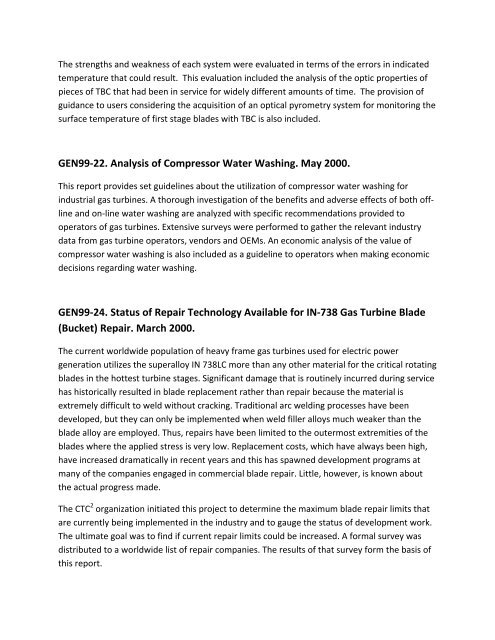GE94-02: Repair Flow Testing and Calibration Procedures for ...
GE94-02: Repair Flow Testing and Calibration Procedures for ...
GE94-02: Repair Flow Testing and Calibration Procedures for ...
Create successful ePaper yourself
Turn your PDF publications into a flip-book with our unique Google optimized e-Paper software.
The strengths <strong>and</strong> weakness of each system were evaluated in terms of the errors in indicated<br />
temperature that could result. This evaluation included the analysis of the optic properties of<br />
pieces of TBC that had been in service <strong>for</strong> widely different amounts of time. The provision of<br />
guidance to users considering the acquisition of an optical pyrometry system <strong>for</strong> monitoring the<br />
surface temperature of first stage blades with TBC is also included.<br />
GEN99‐22. Analysis of Compressor Water Washing. May 2000.<br />
This report provides set guidelines about the utilization of compressor water washing <strong>for</strong><br />
industrial gas turbines. A thorough investigation of the benefits <strong>and</strong> adverse effects of both off‐<br />
line <strong>and</strong> on‐line water washing are analyzed with specific recommendations provided to<br />
operators of gas turbines. Extensive surveys were per<strong>for</strong>med to gather the relevant industry<br />
data from gas turbine operators, vendors <strong>and</strong> OEMs. An economic analysis of the value of<br />
compressor water washing is also included as a guideline to operators when making economic<br />
decisions regarding water washing.<br />
GEN99‐24. Status of <strong>Repair</strong> Technology Available <strong>for</strong> IN‐738 Gas Turbine Blade<br />
(Bucket) <strong>Repair</strong>. March 2000.<br />
The current worldwide population of heavy frame gas turbines used <strong>for</strong> electric power<br />
generation utilizes the superalloy IN 738LC more than any other material <strong>for</strong> the critical rotating<br />
blades in the hottest turbine stages. Significant damage that is routinely incurred during service<br />
has historically resulted in blade replacement rather than repair because the material is<br />
extremely difficult to weld without cracking. Traditional arc welding processes have been<br />
developed, but they can only be implemented when weld filler alloys much weaker than the<br />
blade alloy are employed. Thus, repairs have been limited to the outermost extremities of the<br />
blades where the applied stress is very low. Replacement costs, which have always been high,<br />
have increased dramatically in recent years <strong>and</strong> this has spawned development programs at<br />
many of the companies engaged in commercial blade repair. Little, however, is known about<br />
the actual progress made.<br />
The CTC 2 organization initiated this project to determine the maximum blade repair limits that<br />
are currently being implemented in the industry <strong>and</strong> to gauge the status of development work.<br />
The ultimate goal was to find if current repair limits could be increased. A <strong>for</strong>mal survey was<br />
distributed to a worldwide list of repair companies. The results of that survey <strong>for</strong>m the basis of<br />
this report.


